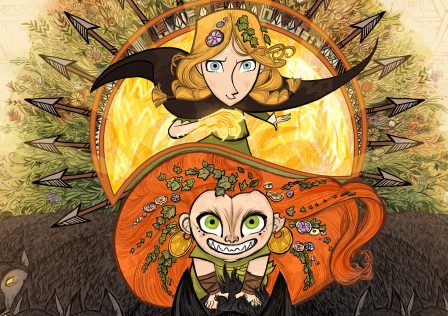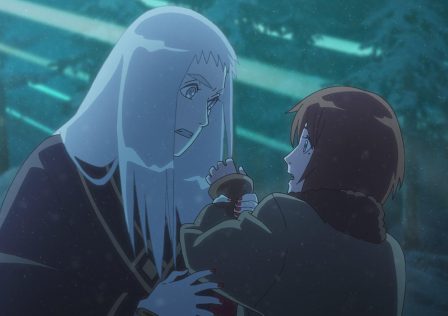Anime sits at a fascinating crossroad. Here is an industry in which the animation process is almost entirely digital, with computers being employed for colouring, filming and editing. But it’s also an industry that still values hand-drawn animation and backgrounds. Sure, you occasionally get fully-CGI titles like Beastars, Hello World and AJIN: Demi Human, but the majority of anime still prefer a combination of hand-drawn animation with digital help for traditionally tough-to-handle elements like traffic, water and crowds.
It’s a middle ground that works. It has been working for years now – Studio Ghibli may tout that Ponyo is done with little to no computer assistance, but in 1997 they were among the pioneers of CGI in anime with Princess Mononoke, in which the writhing and truly terrifying tatarigami was created using computers. And then there’s Katsuhiro Otomo’s Steamboy, the most expensive anime movie to date, which contained 440 CG cuts on top of its 180,000 drawings. The critically-acclaimed Your Name and Weathering with You by animation force-of-nature Makoto Shinkai are also hand-drawn but coloured digitally.
Yet, a question hovers over the industry: what next? Enter Sol Levante.
A co-production of Netflix and Japanese studio Production I.G. (which made Ghost in the Shell), Sol Levante is an animated short that tracks a young warrior in a search for a place said to fulfil wishes, while having to battle ancient guardians and spirits of the land.
In a way, it sounds like the story of how Sol Levante was born – a navigation among aged practices and archaic habits to make a dream come true.
The dream, in this case, is to make one of the world’s first 4K and HDR native hand-drawn anime short. Director Akira Saitoh of Production I.G. had long been fascinated by the prospects of 4K and HDR technology to remove current obstacles in animation and elevate storytelling through the visual medium.
Colours and hues that cannot be rendered on screen using conventional animation techniques, for example, would no longer be a limitation, explains Saitoh through an interpreter during a recent virtual media roundtable.
4K refers to a screen resolution of around 8 million pixels – four times the picture quality than that of a 1080p content. HDR is short for High Dynamic Range, which is the contrast or colour range.
Sol Levante’s director Akira Saitoh (left) and Haruka Miyagawa, Creative Technology Engineer of Creative Technologies and Infrastructure at Netflix
Haruka Miyagawa, Creative Technology Engineer of Creative Technologies and Infrastructure at Netflix, explains that animating in 4K is much like using a bigger canvas to draw a picture, giving filmmakers more flexibility to decide if more or fewer details should be on the canvas. HDR, on the other hand, is like giving filmmakers “a huge box of crayons with all the colours.”
It shows. Sol Levante bursts with energy and flourish. The plot is thin, but the eyes can scarcely take in the dance of details that envelops the screen.
Netflix, according to Miyagawa, has supported 4K streaming since 2015 and HDR streaming since 2016. The platform has also been pumping out Japanese anime every year since 2017. Hence, combining all three elements seems like a logical next step.
Unfortunately, one step for Netflix is a huge leap for Japanese animators.
“I talked to several anime studios and the initial response was: ‘If we want to do 4K, we need a bigger paper [to draw on], and if the paper is big, we can’t flip them for the animation, so we can’t do 4K’. That was the general reaction from the majority of anime studios, but luckily, we found a very small team with Saitoh-san and Production I.G., who has been testing 4K and HDR by themselves, and they wanted to explore more and needed more help from outside [sources]. So it was a perfect match for us to work together to finish this project,” says Miyagawa, who is also the executive producer for Sol Levante.
Saitoh explains that her team is driven by the curiosity on how far they can push animation given the current technology available. Yet, it is difficult for animators in Japan to get support from conventional channels, be it broadcasters or studios, to take on new and bold projects.
Then, Netflix entered the picture. Saitoh’s team now has the backing of a deep-pocketed platform to incorporate new technologies for their high-concept experiment.
Yet, the production of Sol Levante was not without hiccups. Circumventing the paper size issue meant drawings had to be done on a tablet, but the team found that most anime artists lack the training and equipment to go digital.
Animator Hisashi Ezura working on Sol Levante
Sol Levante itself was made with a team of only six people wearing multiple hats; Saitoh herself directed the short and also created all the backgrounds and VFX work. The four-minute visual spectacle took two years to make.
The talent gap is the biggest hurdle to expand the anime short into a full-length feature. According to the director, solving the human resource issue would shorten the production timeline, hence she hopes to collaborate not only with Japanese animators but also overseas studios that are keen to explore this new technology.
Besides navigating the complex traditional anime production model, the team also had to make do with outdated technology in the industry that did not support the additional brightness and colour gamut available to them in HDR.
In a follow-up email interview, Netflix tells DeconRecon that the barrier “is a combination of production resources, lack of readily available equipment and trained animators to fully use those technologies.”
“For 4K animation to be adopted in the mainstream anime industry, there is significant room for investment for readily available, inexpensive equipment for creators and animators. Once 4K HDR monitors are widely available at an affordable price, it’s only a matter of time until it is commercially viable,” the platform replies.
The team that brought Sol Levante to life
But, for now, a wide take-up of 4K and HDR anime remains a distant dream. Saitoh observes that most Japanese studios still seem hesitant to adopt the new technologies required.
That said, the devotion to traditional techniques is not a blemish — anime is seen as one of the last bastions for hand-drawn animation. Even Saitoh admits that characters drawn with the pencil is more “enchanting”.
“A lot of the animation creators in Japan are so used to creating within a very restrictive environment using the conventional format. With 4K and HDR technology, there is no need to make these compromises. It actually enables you to render your artistic vision from the mind to the screen. I believe that there are no creators out there who would say no to this if given the opportunity,” explains Saitoh.
Miyagawa also hopes that the short can inspire meaningful conversations among Japanese studios and animators on “their dreams and visions which has never been possible before, but could be done with these technologies.”
This is why Sol Levante is an open-source project. Netflix has released raw materials used in the short for download and experimentation.
“Everyone will have access to the assets, and they can play with it to get new ideas,” she says.
Sol Levante is Italian for ‘the sun rising from the East’. Saitoh sees it as a metaphor for Japan, while also signalling a new dawn for creative technology in anime. But will the industry see the light? The future is a blank canvas.
Also published on Medium.

When more heads are better than one.



